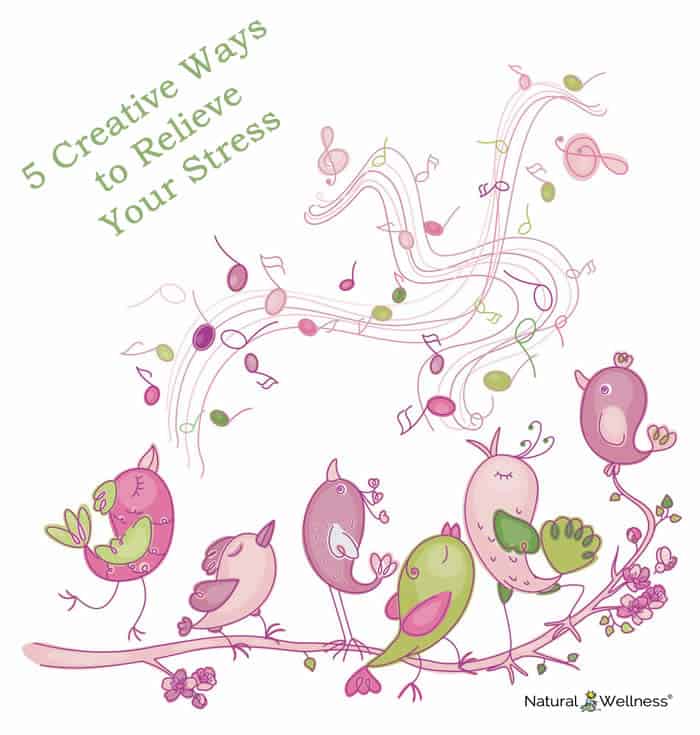

Ah, stress. The emotion that pops up into our life whether we like it or not, sometimes when we least expect it. We’ve heard the common stress-relieving strategies before such as exercise, meditation, and spending time with loved ones. They are definitely beneficial, but maybe you want to try out different ways to overcome stress.
Here are some uncommon stress-busting techniques to add into your routine.
1. Sounds Can Reduce Stress
There’s nothing quite like hearing the whistles and chirps of the birds early in the morning (unless you wanted to sleep in!). It seems to get you into a good mood and prepare you for your day. The Journal of Environmental Psychology (1) found that bird songs and calls were helpful with stress recovery in adults as well as reestablishing attention.
Listening to music can also benefit stress levels, according to a study published in Psychoneuroendocrinology. (2) This study examined 55 university students and tested stress levels during regular term weeks and during examination weeks. The participants rated their current music-listening along with their stress levels four times per day.
Results found that listening to music was an effective option when aiming to reduce stress, especially when the reason was to relax. When individuals were aiming to relax, they listened to music that was calm and relaxing. Doing so reduced alpha-amylase activity. Alpha-amylase is an enzyme that increases in response to psychological stressors. Listening to energetic music actually increased these enzyme levels, which may mean they are less likely to reduce stress levels.
Don’t expose yourself to a lot of noise for long periods of time. Harvard Medical School (3) states that doing so can put you at risk for heart attacks and strokes. The reason for this is because high levels of activity in the amygdala (an area of our brain involved with emotional response and stress regulation) increases blood vessel inflammation, which is a risk factor for heart disease.
2. Color Therapy Can Lower Stress

Certain colors can be therapeutic, and color therapy is believed to change a person’s mental, physiological, and emotional health. The Liceo Journal of Higher Education Research (4) discusses Edwin Babbit who created the principles of Light and Color in 1878. These principles believe healing can be done with color.
Babbit broke down the colors as followed:
- Red: stimulant, notably to blood and not as much to nerves
- Yellow/orange: nerve stimulants
- Blue/violet: soothing to all symptoms and included anti-inflammatory properties
The same journal discusses reports of a governor of a prison who had wings that were painted different colors. The governor and staff of the prison reported different behaviors of prisoners depending on which wing they lived in. The red and yellow wings saw an increase in violence compared to those who lived in the blue and green wings.
Besides blue, violet, and green – pink is also a color that has been found to have a tranquilizing and calming effect within a few minutes of being exposed. The study pursued in this journal wanted to compare how stress levels changed when students were exposed to blue and pink color therapy.
The end result found that both blue and pink color therapies were helpful in reducing stress in nursing students going through their clinical duties. Both are soothing colors, but blue had a stronger effect.
3. Essential Oils
Known for their aromatherapy use, essential oils are compounds that are extracted from plants. When certain essential oils are inhaled, they can activate areas of your limbic system which is the part of your brain that affects emotions and behaviors. (5)
The Journal of Korean Academy of Nursing (6) published a study to identify how certain scents influenced blood pressure and stress responses. The study used 52 participants who were divided into 3 different groups. The essential oil group inhaled a mixture of three different oils – lavender, ylang ylang, and bergamot once a day for 4 weeks.
It was found that inhaling these essential oils was effective in terms of:
• reducing psychological stress
• serum cortisol levels
• and blood pressure of participants with hypertension.
4. Dancing in Your Kitchen

You’re making dinner after a long day of work, but the stress of the day is still lingering. Instead of waiting around for the oven timer to go off, turn on some music and do a little dance!
A study (7) done on 201 Swiss medical university students and 250 exercise and health sciences students compared 4 different exercises and their effect on stress. The 4 exercises included aerobic exercises, ball sports, dancing, and weightlifting.
When participants with elevated stress were frequently involved with ball sports and dancing, they had decreased depressive symptoms. Aerobic exercises did not have any stress-moderating effect, and weightlifting was only associated with lower depressive symptoms when participants already started with low stress levels.
5. Nature Environments Provide Stress Relief
One study published in the Journal of Environmental Psychology (8) investigated how visits to urban nature environments affected phycological and physiological behaviors. These behaviors included mood, creativity, concentration, and others.
With 77 participants involved in the study, researchers had them visit various urban areas. One was a built-up city center (as a control group), an urban park, and an urban woodland. Results of the study showed that both the park and woodland area had a similar positive influence on stress relief, even with short-term visits. Further research should be considered to see how nature exposure affects different groups of people.
Editor’s Note: If you’re still searching for a stress relief option even after reading this article, you might want to look into Natural Wellness’s Stress Relief. This supplement is an extended release formula, so it provides stress relief for the entire day. It includes all natural stress calming herbs such as valerian, hops and skullcap. Learn more.




